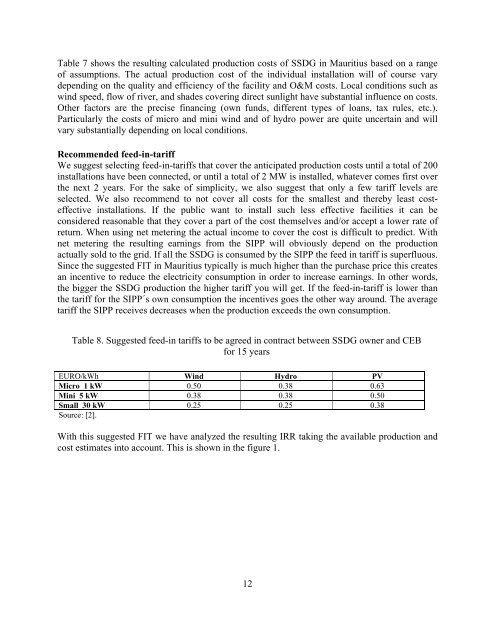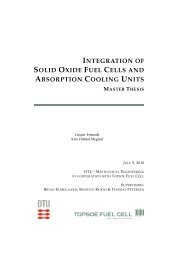Mauritius - a sustainable island - Ea Energianalyse
Mauritius - a sustainable island - Ea Energianalyse
Mauritius - a sustainable island - Ea Energianalyse
You also want an ePaper? Increase the reach of your titles
YUMPU automatically turns print PDFs into web optimized ePapers that Google loves.
Table 7 shows the resulting calculated production costs of SSDG in <strong>Mauritius</strong> based on a range<br />
of assumptions. The actual production cost of the individual installation will of course vary<br />
depending on the quality and efficiency of the facility and O&M costs. Local conditions such as<br />
wind speed, flow of river, and shades covering direct sunlight have substantial influence on costs.<br />
Other factors are the precise financing (own funds, different types of loans, tax rules, etc.).<br />
Particularly the costs of micro and mini wind and of hydro power are quite uncertain and will<br />
vary substantially depending on local conditions.<br />
Recommended feed-in-tariff<br />
We suggest selecting feed-in-tariffs that cover the anticipated production costs until a total of 200<br />
installations have been connected, or until a total of 2 MW is installed, whatever comes first over<br />
the next 2 years. For the sake of simplicity, we also suggest that only a few tariff levels are<br />
selected. We also recommend to not cover all costs for the smallest and thereby least costeffective<br />
installations. If the public want to install such less effective facilities it can be<br />
considered reasonable that they cover a part of the cost themselves and/or accept a lower rate of<br />
return. When using net metering the actual income to cover the cost is difficult to predict. With<br />
net metering the resulting earnings from the SIPP will obviously depend on the production<br />
actually sold to the grid. If all the SSDG is consumed by the SIPP the feed in tariff is superfluous.<br />
Since the suggested FIT in <strong>Mauritius</strong> typically is much higher than the purchase price this creates<br />
an incentive to reduce the electricity consumption in order to increase earnings. In other words,<br />
the bigger the SSDG production the higher tariff you will get. If the feed-in-tariff is lower than<br />
the tariff for the SIPP´s own consumption the incentives goes the other way around. The average<br />
tariff the SIPP receives decreases when the production exceeds the own consumption.<br />
Table 8. Suggested feed-in tariffs to be agreed in contract between SSDG owner and CEB<br />
for 15 years<br />
EURO/kWh Wind Hydro PV<br />
Micro 1 kW 0.50 0.38 0.63<br />
Mini 5 kW 0.38 0.38 0.50<br />
Small 30 kW 0.25 0.25 0.38<br />
Source: [2].<br />
With this suggested FIT we have analyzed the resulting IRR taking the available production and<br />
cost estimates into account. This is shown in the figure 1.<br />
12
















